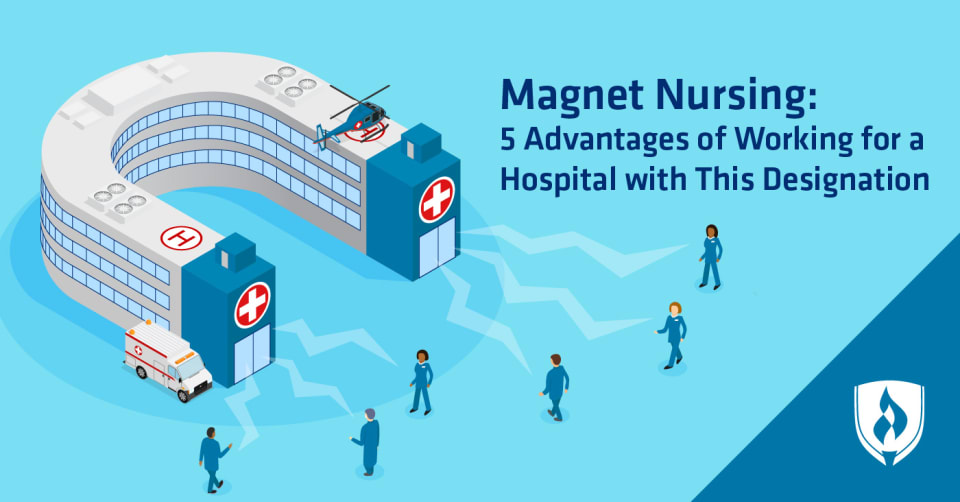Magnet Nursing: 5 Advantages to Working in a Hospital with This Designation
By Anjali Stenquist on 04/13/2020

Nursing is one of the most respected and essential roles within healthcare. If you want to be among the most cutting-edge, highly-trained and well-positioned nurses in the field—you might want to consider working at a hospital with Magnet® status.
Magnet status is awarded by the American Nurses Credentialing Center (ANCC) as a recognition of hospital facilities dedicated to excellence in nursing. Aside from the prestige, working at a Magnet hospital has many tangible advantages for nurses.
So what does that mean? We looked at the research on how Magnet hospitals compare to hospitals without Magnet status, and found five key advantages for nurses working at a Magnet hospital.
Get Your Nursing School Questions Answered at a Nursing Information Session
What is a Magnet hospital?
The Magnet Hospital Recognition Program for Excellence in Nursing Services (now the Magnet Recognition Program®) was first created in 1990 by the ANCC. The program drew on research conducted by the American Academy of Nursing, which identified 14 characteristics of healthcare facilities that successfully recruited and retained nurses.
These 14 characteristics were nicknamed the “Forces of Magnetism” because of their ability to bring in and keep on the most qualified nurses. The Forces of Magnetism fall into 5 Components the American Nurses Association used as a framework to create the distinction of “Magnet” status.
The 5 components of a magnet hospital
- Transformational Leadership
- Structural Empowerment
- Exemplary Professional Practice
- New Knowledge, Innovation and Improvements
- Empirical Quality Results
In 1994, the American Nurses Credentialing Center recognized The University of Washington Medical Center as the first hospital to earn Magnet status. The Magnet status eventually included long term care facilities and health care facilities outside the US.
To be considered for Magnet status today, a facility must demonstrate nursing leadership, employ nurses with certain education requirements, submit a Magnet application, arrange a site visit, follow a set of guidelines created by the American Nurses Credentialing Center for a four year period, and finally, reapply for Magnet designation.
As you can see, earning Magnet status is no small task—it takes significant time and resources for healthcare facilities. However, the long term benefits for the hospital, patients and nurses are well documented.
5 Advantages for nurses working at a Magnet hospital
Numerous studies have been done to evaluate the outcomes of hospitals with Magnet status. After examining the research, we found 5 specific advantages for nurses who work within a Magnet hospital.
1. Better job satisfaction
The most straightforward advantage for nurses working in a Magnet hospital? Greater job satisfaction. A study on nurse outcomes in Magnet and Non-Magnet hospitals found nurses working in hospitals with Magnet status were 18 percent less likely to be dissatisfied with their job than nurses working in non-Magnet hospitals.1
Magnet hospitals are singled out for the quality of their nursing staff. They have proven a high standard of care and leadership within the hospital administration. For a hospital to receive Magnet status, it most have a Chief Nursing Officer among the hospitals highest governing decision-making and strategic planning bodies.
With nurses in positions of leadership within the hospital, they are able to institute changes that benefit nurses and improve nurse job satisfaction.
2. Safer for nurses, safer for patients
A chapter on the relative safety of Magnet Hospitals published in Patient Safety and Quality: An Evidence-Based Handbook for Nurses found that not only was patient safety improved in hospitals with Magnet status, the safety of nurses was improved as well.2
Though the potential causes of safety issues and improvements within a healthcare facility are complex, it is possible the requirements given by American Nurses Credentialing Center for facilities applying for Magnet status positively impact hospital safety. Nurses who feel empowered to speak up and report potentially unsafe conditions or patient issues combined with leadership who are dedicated to continuous improvement in these areas can make a difference.
3. Less potential for burnout
Occupational burnout is the result of chronic work-related stress—and nurses are certainly not immune to these issues. Some suggest burnout is associated with worse job performance, coronary heart disease and poor mental health outcomes. Obviously it’s not a great situation for caregivers to be in such a rough spot—but it does appear that nurses who work in Magnet hospitals are less likely to reach that point.
The same study that found higher job satisfaction for nurses working in a Magnet hospital also found a 13 percent lower rate of burnout among nurses at hospitals with Magnet status when compared to nurses working at non-Magnet locations.1
Nursing is a highly stressful profession. Lower rates of burnout and higher job satisfaction can be critically positive influences on a nurse’s quality of life.
4. Support for professional development
Part of the criteria for a hospital’s Magnet status is directly tied to having nurses placed in positions of leadership within the organization. Because of this, working in a Magnet hospital gives nurses the ability to potentially influence hospital administration by entering into leadership positions.
This institutional framework of support for nurses can result in greater opportunities for professional advancement into managerial or administrative roles. There’s also a vested interest in making sure their nursing workforce is well-trained and held to a high standard, which can present opportunities for professional development.
5. Lower patient mortality
Apart from the many direct benefits to nurses in a Magnet hospital, a study published in Medical Care, Official Journal of the Medical Care Section of the American Public Health Association, found patient mortality rates were significantly lower in hospitals with Magnet status.3 Researchers found that patients treated in Magnet hospitals had 14 percent lower odds of mortality when compared to patients at non-Magnet hospitals. Additionally, patients had 12 percent lower odds of a failure-to-rescue during surgical procedures at a hospital with Magnet status.3
Not only does working at a Magnet hospital offer nurses better working conditions, greater job satisfaction and leadership opportunities, it allows nurses to do their job better and help effectively treat more patients in critical condition.
Could working at a Magnet hospital be in your future?
Magnet hospitals require all nurses in leadership positions to have a Bachelor of Science in Nursing. If you are interested in working at a Magnet hospital, it’s beneficial to already have a BSN. While potentially working at a Magnet hospital could be one solid reason to consider earning a BSN, there’s plenty of others worth considering.
1The Journal of Nursing Administration, Nurse Outcomes in Magnet and Non-Magnet Hospitals, [accessed March, 2020] https://journals.lww.com/jonajournal/Abstract/2011/10000/Nurse_Outcomes_in_Magnet__and_Non_Magnet_Hospitals.9.aspx
2Lundmark, Vicki A., Patient Safety and Quality: An Evidence-Based Handbook for Nurses, Chapter 46: Magnet Environments for Professional Nursing Environments [accessed March, 2020] https://www.ncbi.nlm.nih.gov/books/NBK2667/
3Medical Care: Official Journal of the Medical Care Section, American Public Health Association, Lower Mortality in Magnet Hospitals [accessed March, 2020] https://journals.lww.com/lww-medicalcare/Abstract/2013/05000/Lower_Mortality_in_Magnet_Hospitals.2.aspx


.png)

